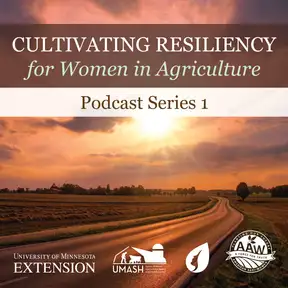#2: What is Stress?
This session focuses on stress and defining it in the context of agriculture and farming.
This session focuses on what is stress in the context of agriculture and farming. Shauna Reitmeier and Brenda Mack discuss signs of stress, including how to define positive and negative stress as well ways to know when stress is becoming a problem for you.
Transcript
Megan Roberts: Welcome to this session of our Cultivating Resiliency for Women in Agriculture podcast, series one. The Cultivating Resiliency project develops tools for women in agriculture to recognize, adapt to, and develop positive coping strategies to life stresses. This podcast series is developed from our cultivating resiliency webinars sessions. I'm Megan Roberts and I co-lead this project along with Doris Mold. In this podcast, we feature Shauna Reitmeier and Brenda Mack as our session hosts. Shauna and Brenda are professionals in behavioral health with family ties to farming. This session focuses on what is stress. Shauna and Brenda talk about a checklist of signs of stress during this session. Before they begin, I want to review that list, which includes insomnia, mood changes, inability to make decisions, distraction, physical appearance changes, withdrawal from others, feelings of hopelessness, increased alcohol use. Shauna and Brenda will help you define stress in this session, as well as discuss ways to know when stress is becoming a problem for you. Here's Brenda.
Brenda Mack: What I want you to do right now is I want you to shut your eyes and I want you to take three deep breaths. And I want you to think about what is your unique definition of farming or ranching or agriculture related stress? And what are your unique farming, ranching, and agriculture related challenges or difficulties that cause you excessive worrying? There are many different causes and symptoms related to stress, pertaining to women in farming and ranching. [inaudible 00:02:08] defines stress as a fact of nature in which forces from the inside and outside world affect an individual, affects an individual's emotional or physical well-being or both, and the individual responds to stress in ways that affects not only you, but also other people in your environment. And, there is an overabundance of stress in our modern lives. We usually think of stress as a negative experience, and we are focusing a bit today on negative stress as opposed to positive stress, because we want to focus on when it's not working for you and try to give you some ideas and strategies that might help under those circumstances.
Megan Roberts: Now here's Shauna to describe how to recognize when stress moves beyond positively affecting our lives and begins to negatively impact us.
Shauna Reitmeier: We experience stress and we know that there's those tensions in our relationships. Sometimes it's hard for us to really understand what does that look like to yourself? Like you might see it in the person next to you, but you're also in that household, or you're seeing someone. Negative stress really... I mean, it can look very different for each person. So one person might not be able to sleep. Another can sleep... It might be sleeping too much, or not being able to wake up. Mood changes. So many decisions need to be made and then it's hard to make them because there's too many and feeling a bit overwhelmed. The other one that I think about as well is, if we get distracted and that's where, are you having accidents? Are you bumping your head? Are you falling down in certain things because we're not paying attention to what we're doing because we're thinking about all the other things versus what we're doing right at that moment. And so... But these are all things that you can be looking at to see, is stress looking like this for me? Is this looking like this for somebody that I know, as well? And one of the first steps I think in using that checklist is that's going to give you some self-awareness. So if you check off three or four of that list and say, oh, I know that I think I am, these aren't working for me anywhere. No longer has the, what was seemed to be positive stress because it gave me a little energy or a little boost, no longer is positive and turning negative.
Megan Roberts: This is Megan again. Thanks for joining us on this Cultivating Resiliency for Women in Agriculture podcast, series one. In this session, we learned about stress and what it is. While stress can be positive, an overabundance of stress can negatively affect our lives. Signs of stress are expressed differently in different people. After listening to Brenda and Shauna, did you identify signs of stress in yourself or others? Developing positive coping strategies and self-talk can help you address stress and increase your resilience to stress. We address that in our next podcast, which focuses on coping with stress, positive self-talk. This project is a collaboration of American Agri-Women, District 11 Agri-Women, University of Minnesota Extension Women in Ag Network, and the Upper Midwest Agricultural Safety and Health Center, UMASH. You may find recordings for our entire webinar series on the UMASH or American Agri-Women websites under cultivating resiliency.

